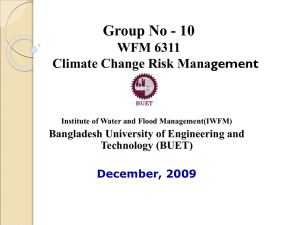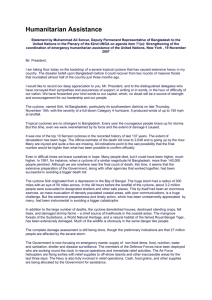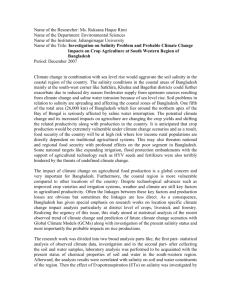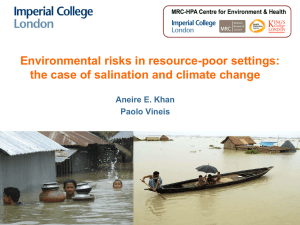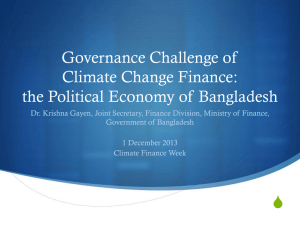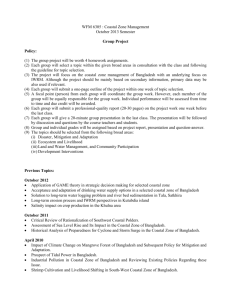Environment and Climate Change
advertisement
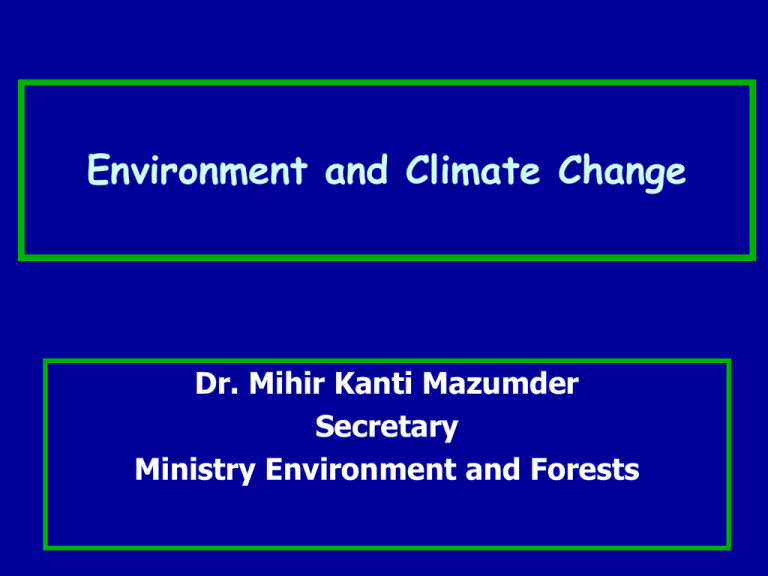
Environment and Climate Change Dr. Mihir Kanti Mazumder Secretary Ministry Environment and Forests Environmental Degradation • Environmental degradation is a serious concern. • These include: degradation of land, wetland and water bodies, forests, biodiversity loss, arsenic contamination in ground water, surface water pollution, air pollution, solid waste disposal problems in cities and towns, salinity intrusion in coastal zone and many localised ones. • These such as biodiversity loss some time aggravate climate change impacts such as food insecurity – need therefore to be managed in a holistic and integrated manner Climate change impacts • Cyclone/storm surge: increased frequency, intensity, increasing salinity • Flood: increased frequency, magnitudes • Droughts: Spreading over time and space • Erratic rainfall: Intensive rain in short time • Temperature: extremes increasing • Riverbank and coastal erosion: increasing • Water logging and permanent inundation due to SLR Drought Cyclone Storm surge, salinity Hazards Bangladesh faces Flood Water logging Bank Bank erosion Erosion Drought, Floods, Cyclones likely to exacerbate in future due to climate changeCountry still reeling from devastation due to Cyclone Aila. Disaster risk reduction strategy need strengthening. Climate Change Risks • Extreme events- increased hazards with potential to increased disasters – More/intense/frequent floods/droughts/cyclones/storm surges etc • Slow onset / gradual effects leading to disasters – Salinity intrusion, river bank erosion, temperature variability, erratic precipitation etc. •Climate Change also has severe social impacts that will cause internal and external migration of displaced community Impact of AILA …… Embankment breached during Aila remains unrepaired & water rushes inside the poldered areas Impact of AILA People’s Response to Post-Aila Situation People migrate from Kalabogi Village, Dacope Resilience • Despite continued CC-related disasters BD economy has continued to grow – poverty has fallen; major social gains such as gender equity in primary education, IMR decline, life expectancy increased • Food production continues to grow • But continued CC will literally wash away such achievements Challenges of Climate Change • Bangladesh is an innocent victim of adverse impacts of Climate Change. • To manage the impacts, Bangladesh has taken a two-pronged approach. -It has been vigorously participating in the international negotiations process for realisation of the goals under the Bali Action Plan -as well as preparing itself at home for necessary domestic action. Climate Change: Bangladesh Response Prepared National Adaptation Programme of Action (NAPA) in 2005; identified 15 Priority projects. Prepared Initial National Communication and preparing Second National Communication. Made climate change an integral part of the new draft Poverty Reduction Strategy Paper (PRSP) Developed Bangladesh Climate Change Strategy and Action Plan (BCCSAP 2009) National Water Management Plan Challenges of Climate Change • The cornerstones of all actions, international or domestic, are to ensure security of food, water, energy and, livelihood (including health). • BCCSAP 2009 has laid out Bangladesh’s possible response to impacts of climate change. • BCCSAP contains 6 themes and 44 programme areas. • Establishment of Climate Change Trust Fund with an allocation of US$ 100 m for this year • Implementation is ongoing Agriculture & food Security Challenges • Country is now largely food secure – but limits of rice cultivation has been reached in dry period with ground water irrigation • Paradigm shift to wet period aman rice needed – aman, however, is highly susceptible to adverse impacts of climate change Health and Nutritional Challenges • Arsenic contamination poses major threat to health • Re-emergence of vector borne diseases • Increased malnutrition among the poor contribute to the spread of communicable and non-communicable diseases • Increased incidence of different degenerative diseases due to salinity intrusion Development Approaches….. • Climate change as well as environmental degradation has to be faced in an integrated and well-coordinated manner by all sectors. • Accordingly, the Sixth Five Year Plan under preparation at present is expected to provide an integrated approach to economic and social development incorporating these challenges and opportunities. Development Approaches….. • Government is aware of the multifarious and interactive nature of climate change and environmental degradation problems • Appropriate sectoral policies are therefore being harmonised, and laws are being revised and upgraded. • Human and institutional capacity for effective monitoring of nature and extent of degradation need to be enhanced. • Prioritisation of BCCSAP 2009 programmes has been taken up in earnest. Development Approaches………. • Key to adaptation under climate change is proper management of water resources including maintenance of river flow through capital dredging • Rehabilitation of coastal and other areas through strengthening of water reservoir and polder programmes • Community-based and co-management of forests including coastal greenbelt, biodiversity and wetlands etc. Development Approaches………. • Strengthening of community-based disaster risk reduction programme • Disaster management and Relief Division has identified immediate need for establishing new 2000 coastal cyclone shelters, 2000 flood victim shelters, 150000 storm proof house in the coastal area, 60000 houses for river erosion victims (estimated cost US$ 1.22 b) Regional Cooperation • Effective water and ecosystem management in Bangladesh calls for strengthening of GBM regional cooperation in terms of basin-wide river management and joint water development and watersharing activities by the regional countries Recent Success To be Built Upon ….. • Bangladesh has already developed salinity tolerant, flood tolerant and shorter maturity varieties of rice. This will help in the short run. • Extensive agricultural extension services are needed to make these varieties available to the farmers. • But this is only the beginning: more varieties and appropriate ecosystem-based agricultural system need to be developed and popularised Research, Knowledge Management & Capacity Building • Continuous research, monitoring and knowledge management and development and transfer of technology, are needed to manage climate change and its impacts. • One immediate need is to start multi-disciplinary human capability development planning and implementation for climate and environmental management. • Intensive training program for climate displaced community to adapt and cope with new situation On Finance…. • The government has identified an urgent need for US$ 10 billion over 5 years. • This fund is mostly expected to be raised through bi-lateral and multilateral sources, while the government will also make possible contribution Thank you for your patience
